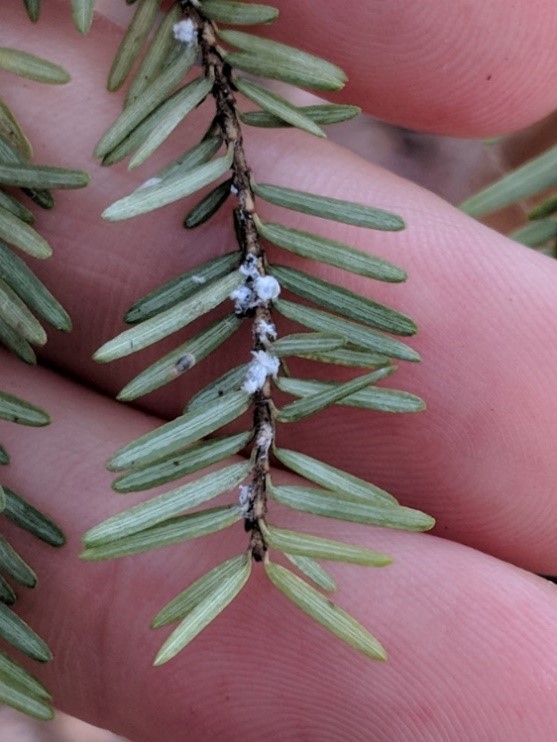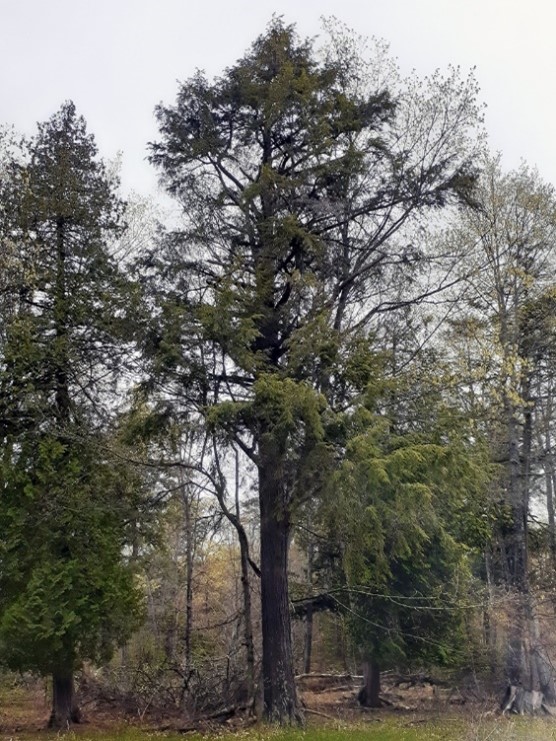

October 5, 2023
An invasive forest insect known as the Hemlock Woolly Adelgid (HWA, Adelges tsugae) has been confirmed by the Canadian Food Inspection Agency (CFIA) in Haldimand County on the Niagara Peninsula. This detection was facilitated through the HWA Community Science Monitoring Program, a collaboration between the Invasive Species Centre, CFIA, and Natural Resources Canada.
The HWA is a species native to Eastern Asia that targets hemlock (Tsuga spp.) and spruce (Picea spp.) trees. First discovered in Virginia in the 1950s, it has since spread across North America. This insect is problematic to our native Eastern hemlock trees (Tsuga canadensis), relying on them as their host as there are no known spruce hosts that are suitable for HWA reproduction in North America. The HWA extracts and feeds on the sap from the base of the tree needles, causing branch dieback and eventual tree mortality. It can be spread by wind, animals, and human movement of nursery stock, logs, and other wood products.
Left unmanaged, this pest can severely disrupt forest ecosystems. Eastern hemlocks are important for wildlife and maintain the health of forest rivers and streams. Outdoor recreation in parks and other urban green spaces may also be negatively impacted. Although they may not contribute a significant economic value to the forestry industry, hemlocks are often sold as nursery stock, posing a threat to the horticultural industry.
What Community Members Can Do
Tree nursery and landowners can check for signs and symptoms of the HWA on Eastern hemlock trees including:
- White “woolly” sacs resembling tiny cotton swab ends at the base of hemlock needles on young twigs; most obvious in the spring
- Premature bud and shoot dieback
- Premature needle loss
- Thinner, greyish-green crown (healthy crowns are a shiny, dark green colour)
- Dieback of twigs and branches
- Discoloured foliage
- Death within 4 to 15 years
Community members can avoid placing bird feeders near hemlock trees because birds can spread HWA to new locations. Additionally, they shouldn’t move firewood because it increases the risk of spread for invasive forest pests that can hitchhike on firewood.
If an infestation is suspected, please report it online to the Canadian Food Inspection Agency (CFIA). A good report includes an accurate location of the suspect tree and photos of the symptoms. The CFIA will respond to reports of the HWA and take appropriate action, which may include site surveying and sample collection.
Get Resources
The Invasive Species Centre HWA species profile has resources available to learn more about the HWA, including a factsheet, survey protocol, and webinar about potential impacts. An online HWA Training Course through the Invasive Species Centre’s Training Program is currently under development.
About the Invasive Species Centre
The Invasive Species Centre is a not-for-profit organization that prevents the spread of invasive species in Canada and beyond by connecting with stakeholders to catalyze invasive species management and communicate policy and science knowledge. Visit our website at www.invasivespeciescentre.ca to learn about invasive species, get technical information, register for events, sign up to receive news, and take action on invasive species.
Media contact:
Deborah Sparks
Business Development and Communications Manager
Invasive Species Centre
media@invasivespeciescentre.ca
705-255-8301
